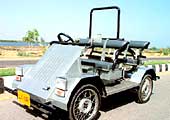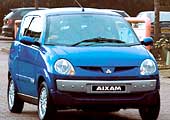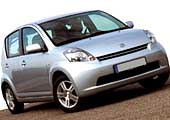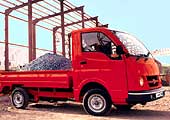|
 In
an e-mail interview, Tata Group Chairman Ratan
Tata fielded questions on his Rs 1-lakh car. Excerpts: In
an e-mail interview, Tata Group Chairman Ratan
Tata fielded questions on his Rs 1-lakh car. Excerpts:
Is it possible to build a car for Rs 1
lakh? If yes, will it indeed be a car?
Right now, it wouldn't be appropriate to give
too much detail on the car. Closer to the time it's in the market,
it would be right to talk about it. However, I can explain to
you the concept. Before I do that, I should mention that the one
lakh figure did not come from me. It was imprinted in the media
by one of the journalists to whom I had talked about the small
car in large volumes and he asked me at what price would the car
sell. I said it would be about 1,00,000 rupees or so. This was
blown out of proportions. So, rather than getting distressed,
I took it up as a challenge. There is nothing sacrosanct about
the one-lakh figure. In my opinion, it is a ballpark figure that
we hope to address, but undoubtedly we need to bear in mind inflation
and other market conditions. The car would be positioned between
the motorcycle and the small car.
Conceptually, we are looking at catering to
the Indian market. The intention is that today you see a family
of three or four all crowded on a scooter where you see the kid
standing in the front and the mother holding her baby in her arms.
It should give a family a more weatherproof means of transport.
Thus, we are looking at a product to position it somewhere in
between that market and the lower end of the four-wheeler market.
The route that we looked at is something that would not be a stripped-down
four-wheeler or an upgrade of a two-wheeler motorcycle, but something
that would be on its own, bearing the costs targets we had in
mind.
How far has Tata Motors progressed with
its project for the Rs 1-lakh car? I believe a prototype is ready.
Does it meet your expectations?
We are now at a point where we are going to
start productionising the car. Yes, the prototypes of the car
are running. The issues that we are looking at today are to do
with the costs of steel, and whether it should be a steel version
or be made of engineering plastics. If it is steel, it could be
spot-welded like any other vehicle or it could use modern-day
adhesives. We are looking at both. If it is plastic, we don't
need any adhesives.
We have developed now what would be the structure
of the car. It would be a gearless vehicle powered by a rear-engine
that would seat four-to-five people. On the technology front,
we have gone to Delphi for the engine management system, as in
India there is no electronic engine management system available.
The car would have the continuously variable transmission (CVT)
technology. As regards the styling, we have taken help from the
Italian design house, idea, which earlier worked with Tata Motors
on the Indica.
It would be a family car, not a city car
with two seats. We are looking at two-three kinds of trim levels.
At the fundamental level, it could be a car that might have curtains
instead of doors-more akin to the kind of use a farmer might have.
It will be similar to how a three-wheeler looks today, but being
a proper car that's just like today's car. It will meet all the
emission requirements. The prototypes are currently doing the
test run without the body. Along with the Indica, it would be
the growth focus for Tata Motors in the medium term in the automobile
sector, in which the group could invest up to Rs 30,000 crore
in the next few years.
When does the company hope to commercially
launch the Rs 1-lakh car?
My best estimate would be that in the next
two-and-half to three years-by 2008 the car would be out.
The Global Small Cars
There's a stunning variety of such cars worldwide.
A random look:
 Citroen
C1 Citroen
C1
ENGINE: Petrol-998 cc, 3-cylinder, 68 hp; Diesel-1,398
cc, 4-cylinder, 55 hp
PRICE: Rs 5,13,105-6,67,155
Fifty-seven years after Pierre Boulanger stunned the French automotive
world by launching a "farmer's car", the 2CV, Citroen
continues to boast of a strong portfolio of small cars.
 Sitara Sitara
ENGINE: Petrol, 170 cc, single-cylinder
PRICE: Rs 92,345
The oddball in this selection, the Sitara is Pakistan's people
cart but meant for city traffic. Despite its odd looks, the Habib
Motor-manufactured cart gives 25 km to a litre!
 Smart
Forfour Smart
Forfour
ENGINE: Petrol & Diesel, 1,124 cc-1,493 cc, 3-cylinder,
68-177 hp
PRICE: Rs 5,76,305-13,58,405
This DaimlerChrysler brand is easily the smartest small car on
four wheels, but it's not positioned as a means of cheap personal
transport. If you've bought Smart, you are more interested in
making a statement about yourself.
 Oka
City Oka
City
ENGINE: Petrol, 749 cc, 2-cylinder, 35 hp
PRICE: Rs 3,51,560
First launched in Russia in 1987 by truck manufacturer KAMAZ,
Oka has sold more than 300,000 units. It is still the cheapest
car in Russia.
 Aixam
751 Aixam
751
ENGINE: Diesel, 479 cc, 2-cylinder, 12.9 hp,
PRICE: Rs 4,56,456-5,43,400*
From three- to four-wheelers, and now to cute small cars, this
French micro-manufacturer, with whom Kinetic had tied up to launch
a small car, makes about 13,000 cars a year.
*Not including taxes
 Daihatsu
Sirion Daihatsu
Sirion
ENGINE: Petrol, 1,298 cc, 3-cylinder, 86 bhp
PRICE: Rs 6,30,000
Expect one of the Daihatsu, where Toyota owns 51 per cent, cars
(with a 1-litre engine) in India soon. A plant with an annual
capacity of 1 lakh is expected near Bangalore.
The Quadricycle "Cars"
 |
| Tata's Ace: Meant to shake the Bajaj
bastion |
Do you know what was the vehicle
Henry Ford first made? No, not a car, but a quadricycle. So as
you might have guessed, a quadricycle is a four-wheeler but not
quite a car. According to the European definition, a quadricycle
must not weigh more than 400 kg and carry load in excess of 200
kg, and the output must not exceed 15kw or 20.11 hp. India currently
has no quadricycle standards, but SIAM has submitted two proposals,
since there seems to be (to put it mildly) a divergence of opinion
among its members. It's easy to see why there are differences
among vehicle makes over quad standards. A quad can be used for
a back-door entry into the small car market. Not surprisingly,
there's a lot of action in the Indian automotive industry in the
quad space. Bajaj Auto, most recently, announced that it would
build a commercial four-wheeler, which, at a later date, can be
turned into a passenger vehicle. Bajaj already makes three-wheelers
and has access to a two-wheeler vendor base. Rajiv Bajaj, however,
isn't willing to talk about his quad at this time, and an e-mailed
questionnaire to his office went unanswered.
 |
 |
 |
| Quad on their mind: Bajaj
Auto's Bajaj, M&M's Mahindra and TVS' Srinivasan |
BT learns there are others trying to build quads too. Mahindra
& Mahindra, Piaggio and TVS Motor, for example. Piaggio actually
displayed a quad at last year's AutoExpo. As for TVS Motor, with
the company's Chairman Venu Srinivasan busy fighting two-wheeler
wars, it's unlikely that he will invest precious time and money
into building one. But for M&M, which also didn't reply to
e-mailed questions, it makes eminent sense to launch one. It can
expand its range and reach in the small commercial vehicles segment,
like Tata Motors has with Ace (see picture). Priced at about Rs
2.2 lakh, the Ace sports a 700-cc, 16-hp, two-cylinder diesel
engine borrowed from the Indica (the Tatas literally halved the
engine to suit Ace). Many in the industry see it as a precursor
to the Rs 1-lakh car. Designed as a city commercial vehicle, quads
like the Ace will be aimed at Bajaj's commercial three-wheelers.
There's buzz in the industry that the Tatas are keen to push more
manufacturer-friendly quad standards to use that as a route to
the Rs 1-lakh car. However, Tata Group Chairman Ratan Tata has
denied that his small car will be a quad in disguise.
The Other Rs 1-Lakh Car
 |
| Abhinav Tiwari: Designed the alternative
Rs 1-lakh car |
Ratan Tata isn't the only one dreaming
of building a car for Rs 1 lakh. Little-known Pune-based Conex
AvioAuto's Avinash Belgamwar is another man who dreams of such
a car. He's already got two NID students, Abhinav Tiwari and Amit
Patankar, to desing a protoype for him. While details of how he
plans to productionise the car are not available, Belgamwar is
confident that it can be made and sold for Rs 1.20 lakh, including
taxes.
 Here's
a look at the car's specs: Here's
a look at the car's specs:
Engine: 500-cc, 25-hp rear-mounted,
obviates the need for expensive front-wheel drive system
Fuel: CNG and auto LPG. Designers
promise 25 km per kg of fuel
Body: To keep costs down, designers
plan to use similar dies for both left and right doors
Highlight: Rotating co-passenger
seats for easy entry/exit
-Ahona Ghosh and Kushan Mitra
Dilip Chhabria's Blueprint
For A Rs 1-lakh Car
The Rs 1-lakh, four-seater vehicle is possible,
he says, and takes a look at the product composition and feasibility:
Product Composition: Based on today's
bill of materials (BoM) of Rs 75,000 for a three-wheeler and on
the assumption that a Rs 1-lakh vehicle will drive volumes of
one million plus annually, following would be the product scenario:
2.4 metre overall length, 1.5 metre width and 1.5 metre height,
a three-wheel vehicle with two 8-inch diameter wheels at the front
for stability as well as low floor for packaging efficiencies
and low steering effort with single, 18-inch diameter wheel at
rear.
A large door on either side to facilitate better ingress and
egress, with a centre-point manual rotating side window. Two seats
at front, sitting almost vertically atop the front wheels and
one bench to accommodate two children at rear. Probable power
plant: 600-cc, two-cylinder, air-cooled, rear-mounted and rear-drive
engine. This will afford good power to the 600-kg GVW car-the
weight ratio that can be achieved through a monocoque steel today.
Feasibility: Starting with the assumption of a three-wheeler's
BoM and considering the million-plus volume, the manufacturer
will need to engineer suitable power plant, taking cues from several
such configurations available globally. The three-wheeler setup
is recommended for the obvious benefits of lower emission and
other regulatory norms to comply with as well as the lower costs
associated with far fewer components.
Based on the likely BoM of Rs 70,000 and with the addition of
manufacturing costs of 6 per cent plus the taxation component
(a manufacturing plant set up in the north-east or Bhuj would
be excise-free), and after the inclusion of distribution and marketing
costs, it is possible to make this car at Rs 1 lakh. The main
ingredient being the low amortisation of Rs 500 per vehicle achieved
through a lifecycle volume of 10 million units on a capital outlay
of Rs 500 crore.While a three-wheel configuration might seem to
be noisy, slow, archaic and prematurely developed in light of
our perception of today's three-wheelers, the trick in my proposed
vehicle is one of a tear-shaped, fully cab forward, chic and trendy,
albeit radical, style, which will be coupled with the free-revving,
high-output engine of tomorrow.
Dilip Chhabria is a Mumbai-based
automotive designer
How TVS Group's K. Mahesh Built
a car For Rs 15,000
 |
| Amateur inventor: Mahesh (sitting) with
his son Krishna |
It was 1962, and I was 18, when
I got it into my head that I should build a light aircraft with
imported kit and drawings as advertised in Popular Mechanics.
So I asked my father, T.S. Krishna, for $1,500 (Rs 12,000, according
to the then exchange rate of Rs 8 to a dollar) to import the kit.
"You are not getting anything that flies," was his reply.
As a kid, I used to work in various departments of the TVS service
station every summer, and one fine day-I was on a summer break
in Madurai from IIT Madras, where I was a second-year student-I
decided that I would make a car instead. The question was, how
to go about it?
Roping in the services of a fitter and a technician, I started
with literally drawing the outline of the chassis with a chalk
on the floor, bent GI pipes to make the outline body shape and
welded the cross channels for strength. I scrounged around roadside
repair shops and located an Austin (1950) steering box and tie
rod ends, and slapped a Triumph (300-cc, single-cylinder) engine
(1940 vintage) on it and picked up wheels from a Vespa scooter.
Much like in a cycle, we put a chain from the engine to the rear
wheels, using a single live shaft with no differential! The Triumph
engine had no oil pump, so oil had to be pumped manually, but
the car, which cost me Rs 15,000 or so, worked just the same and
gave me 15 miles to a gallon. But it had no reverse gear and pumping
oil was tricky and messy, so we replaced it with a Royal Enfield
350-cc engine with a reverse gear from a totally written-off mobike,
bought from an insurance company for a grand sum of Rs 750. With
that it was ready for regular use (without a body, of course,
except the mud guards), and I even had it shipped to Madras and
was driving around the city till I graduated from IIT Madras,
where it proved to be quite an eye-turner.
On the city roads, dogs would sometimes chase me, but I was
well armed to deal with them-I used to keep an engine starting
lever handle in case of an attack. Later, my nephew Badri Vijayaraghavan
carried out several modifications to the car and it became a family
favorite; my cousins would drive it around. The longest trip was
driving it to Madurai from Chennai and then to Kodaikanal hills
in 1963. I faced only one breakdown-a broken chain link.
After I graduated, it fell into disrepair as no one was able
to handle this temperamental driving machine, until three years
ago, when I decided to refurbish it. Sometime back I tried driving
it on Chennai roads, but realised that traffic was too much to
do what I did with ease in the 1960s. But it was great fun driving
this machine at 80 kmph. It was registered as an LCV in 1963,
so I am happy it was recognised as a car of sorts.
K. Mahesh is the Chairman &
MD of Sundaram Brake Linings
|




 I
I Citroen
C1
Citroen
C1 Sitara
Sitara Smart
Forfour
Smart
Forfour  Oka
City
Oka
City  Aixam
751
Aixam
751 Daihatsu
Sirion
Daihatsu
Sirion




 Here's
a look at the car's specs:
Here's
a look at the car's specs: